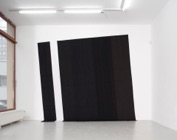Together in Fateful Collision
2009
martial arts belts
Helen Cho’s installations and drawings explore the language of repetition, the simplicity of reduction, and the etymology of single unit-like structures. Her work references Dan Flavin’s serial methodology of using fluorescent lamp as a “colour stick,” a unit to be combined with other units to create building blocks of a system. In Cho’s installations, these units come in the form of colour belts used in the ranking system of martial arts. In a unit-based structure, any number of these mass-produced commercial products may be deployed within the limits of standard issue colours and sizes. Operating within a system of these given limitations and preconditions, Cho develops her own personal language to explore possibilities for the unexpected.
Some inherent aspects and contextual functions, along with certain myths of the sport of martial arts also come into play. Cho is intrigued by the idea that early martial artists begin their training with a white belt that eventually becomes stained black from accumulated years of sweat, dirt and blood; the black belt represents the culmination of a ritualistic journey and reward for physical and mental strength and suffering. In fact, martial arts belts are manufactured commercial products that are accessible to any consumer, upending the assumption that they function within a hierarchical system that can only be accessed through a lifetime of dedication and discipline.
Flavin’s series of white fluorescent lamp sculptures, “Monument to V. Tatlin” (1964 -1990), an homage to Vladimir Tatlin’s unrealized utopian design, “Monument to the Third International” (1920), is used as a point of departure for Cho’s own series of white marital art belt arrangements. These tapestry-like textile constructions are installed on the walls, ceiling and floor of the gallery, illuminated not by white light but rather inhabiting a self-contained stillness, seemingly untouched by time or technology but retaining an indexical relationship to both. Using black marital art belts, Cho creates a monolith-like wall installation that encases an arrangement of white martial art belts. In a reference to Kazimir Malevich’s search for the essence of painting in ultimate reduction, “Black Square” (1915) and the poetic-like dynamics of the tilt in “White on White” (1918), Cho seeks to find ambiguity in absolute monolithic forms and systems. Her installations, with an infrastructure that speaks geometry and hierarchy but are also unexpectedly organic with a democratizing effect on the visual plane, both contain and unsettle these contradictions.








